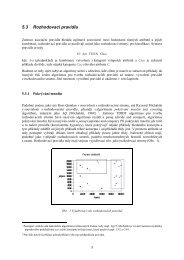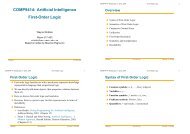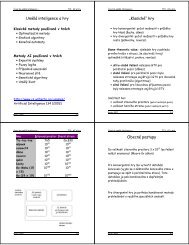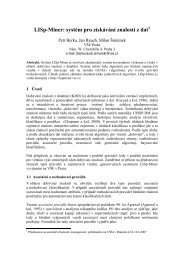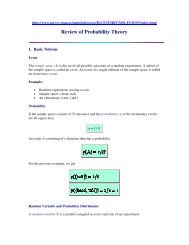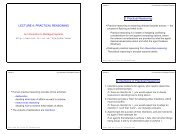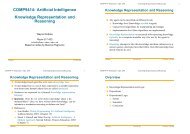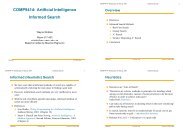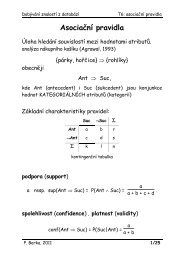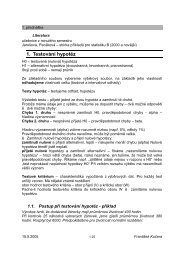Fuzzy Logic - Sorry
Fuzzy Logic - Sorry
Fuzzy Logic - Sorry
You also want an ePaper? Increase the reach of your titles
YUMPU automatically turns print PDFs into web optimized ePapers that Google loves.
AI Module<br />
Linguistic Hedges<br />
APGDST<br />
AI Module<br />
<strong>Fuzzy</strong> inference system<br />
APGDST<br />
The contrast hedges change the<br />
nature of the fuzzy region by<br />
making it either less<br />
fuzzy(intensification) or more<br />
fuzzy(diffusion).<br />
If µ is >= 0.5<br />
1<br />
µ A)<br />
= (<br />
2<br />
1<br />
(<br />
2<br />
µ A<br />
( A))<br />
1<br />
µ A)<br />
= 1−<br />
(<br />
2<br />
1<br />
(<br />
2<br />
µ A<br />
( A))<br />
A fuzzy inference system<br />
essentially defines a nonlinear<br />
mapping of the input data vector<br />
into a scalar output using fuzzy<br />
rules.<br />
else if µ< 0.5<br />
1<br />
µ A)<br />
= 1−<br />
(<br />
2<br />
1<br />
(<br />
2<br />
µ A<br />
( A))<br />
© NCST, 2002 <strong>Fuzzy</strong> <strong>Logic</strong><br />
21<br />
© NCST, 2002 <strong>Fuzzy</strong> <strong>Logic</strong><br />
22<br />
AI Module<br />
Consider a multiinput and multioutput system. Let the input and<br />
output vectors be represented as follows:<br />
x =<br />
T<br />
x<br />
<strong>Fuzzy</strong> inference system<br />
T<br />
x , x , x , x , x ) T<br />
1 2 3 4<br />
( 5<br />
y = ( y , y , y , y , y ) T<br />
x<br />
1<br />
2<br />
T<br />
k<br />
x<br />
3<br />
T<br />
1 1<br />
T ( x)<br />
= { , ,....... }<br />
µ ( x ) = { , ,....... }<br />
i<br />
x<br />
4<br />
The linguistic variable x in the universe of discourse is characterized by<br />
5<br />
1 2<br />
µ µ<br />
x<br />
x<br />
i<br />
µ<br />
x<br />
APGDST<br />
AI Module<br />
. The inputs are<br />
<strong>Fuzzy</strong> inference system<br />
x1=years of education<br />
x2= years of experience<br />
The output is<br />
y=salary.<br />
Let T(x1) = {low,medium,high} for U in range [0-15].<br />
T(x2 )= { low,medium,high} for U in range [0-30].<br />
Let T(y) = {very low, low, medium, high, very high}<br />
for U in range [ 2000, 20000].<br />
APGDST<br />
© NCST, 2002 <strong>Fuzzy</strong> <strong>Logic</strong><br />
23<br />
© NCST, 2002 <strong>Fuzzy</strong> <strong>Logic</strong><br />
24



